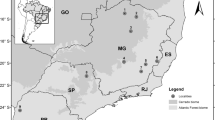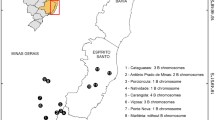Abstract
Cytogenetic analysis of an Idaho population of the checkerspot butterfly, Euphydryas colon, has revealed considerable inter- and intra-individual variation in chromosome number which turns out to be a classic case of B chromosome variation. The basic chromosome complement of the species is n (♂, ♀)=31. The A chromosomes were aligned equatorially at mitotic metaphase and metaphase II, and axially at metaphase I, indicating a restriction of centric activity at the first meiotic division. No failure of pairing between homologous A chromosomes was observed and, although a marked asynchrony of chromatid separation was found to be characteristic of mitotic telophase and telophase II, the frequency of macrospermatid formation was low. The B chromosomes were at least partly heterochromatic but exhibited some variation in both pycnosity and size. Mitotically stable B-containing individuals showed a preponderance of unpaired Bs at first metaphase and these divided at either first or second anaphase. The presence of Bs was associated with a heightened production of abnormal spermatids particularly in individuals with high numbers of B chromosomes. Among the 25 individuals sampled, 21 carried from 1–6 B chromosomes, and of these 14 were mitotically stable. In all 7 unstable individuals the mean number of B chromosomes per cell exceeded the modal number. Assuming that the modal number represents the zygotic number, these results suggest that a mechanism to boost the number of B chromosomes exists in males of E. colon.
Similar content being viewed by others
References
Bauer, D.L.: Tribe Melitaenini. In: How to know the butterflies (P.R. Ehrlich and A.H. Ehrlich) p. 127–246. Dubuque, Iowa: W.C. Brown 1961
Bauer, D.L.: Tribe Melitaenini. In: The butterflies of North America (W.H. Howe, ed.), p. 139–195. New York: Doubleday and Company 1975
Bigger, T.R.L.: Karyotypes of some Lepidoptera chromosomes and changes in their holokinetic organisation as revealed by new cytological techniques. Cytologia (Tokyo) 40, 713–726 (1975)
Bigger, T.R.L.: Karyotypes of three species of Lepidoptera including an investigation of B chromosomes in Pieris. Cytologia (Tokyo) 41, 261–282 (1976)
Ehrlich, A.H., Ehrlich, P.R.: Reproductive strategies in the butterflies: I. Mating frequency, plugging and egg number. J. Kansas Ent. Soc. 51, 666–697 (1978)
Ehrlich, P.R., White, R.R.: Colorado Checkerspot butterflies, isolation neutrality and the biospecies. Amer. Naturalist (in press, 1979)
Ehrlich, P.R., White, R.R., Singer, M.C., McKechnie, S.W., Gilbert, L.E.: Checkerspot butterflies: a historical perspective. Science 188, 221–228 (1975)
Felsenstein, J., Yokoyama, S.: The evolutionary advantage of recombination II. Individual selection for recombination. Genetics 83, 845–859 (1976)
Fontana, P.G.: Improved resolution of the meiotic chromosomes in both sexes of Euxoa species and their hybrids (Lepidoptera: Noctuidae). Canad. J. Genet. Cytol. 18, 537–544 (1976)
Hewitt, G.M.: Meiotic drive for B chromosomes in the primary oocytes of Myrmeleotettix maculatus (Orthoptera: Acrididae). Chromosoma (Berl.) 56, 381–391 (1976)
Hewitt, G.M., John, B.: The B chromosome system of Myrmeleotettix maculatus (Thunb.). IV. The dynamics. Evolution (Lawrence, Kans.) 24, 169–180 (1970)
Hewitt, G.M., John, B.: Inter-population sex chromosome polymorphism in the grasshopper Podisma pedestris. II. Population parameters. Chromosoma (Berl.) 37, 23–42 (1972)
Hsu, T.C.: Longitudinal differentiation of chromosomes. Ann. Rev. Genet. 7, 153–176 (1973)
Hughes-Schrader, S., Schrader, F.: The Kinetochore of the Hemiptera. Chromosoma (Berl.) 12, 327–350 (1961)
Imai, H.T., Crozier, R.H., Taylor, R.W.: Karyotype evolution in Australian ants. Chromosoma (Berl.) 59, 341–393 (1977)
Jones, R.N.: B chromosome systems in flowering plants and animal species. Int. Rev. Cytol. 40, 1–100 (1975)
Labine, P.A.: Population biology of the butterfly Euphydryas editha I. Barriers to multiple insemination. Evolution (Lawrence, Kans.) 18, 335–336 (1964)
Makai, K., Remington, C.L.: Studies of the chromosomes of the North American Rhopalocera. 4. Nymphalinae, Charaxidinae, Libytheinae. J. Lepid. Soc. 14, 179–201 (1960)
McKechnie, S.W., Ehrlich, P.R., White, R.R.: Population genetics of Euphydryas butterflies. I. Genetic variation and the neutrality hypothesis. Genetics 81, 571–594 (1975)
Nur, U.: Maintenance of a parasitic B chromosome in the grasshopper Melanopus femur-rubrum. Genetics 87, 499–512 (1977)
Robinson, R.: Lepidoptera genetics. Oxford: Pergamon Press 1971
Singer, M.S., Ehrlich, P.R.: Population dynamics of the Checkerspot butterfly Euphydryas editha. Z.Ökologie (in press, 1979)
Strobeck, C., Maynard Smith, J., Charlesworth, B.: The effects of hitchhiking on a gene for recombination. Genetics 82, 547–58 (1976)
White, M.J.D.: Animal cytology and evolution. 3rd edit. Cambridge: University Press 1973
Author information
Authors and Affiliations
Rights and permissions
About this article
Cite this article
Pearse, F.K., Ehrlich, P.R. B chromosome variation in Euphydryas colon (Lepidoptera: Nymphalidae). Chromosoma 73, 263–274 (1979). https://doi.org/10.1007/BF00288691
Received:
Accepted:
Issue Date:
DOI: https://doi.org/10.1007/BF00288691




